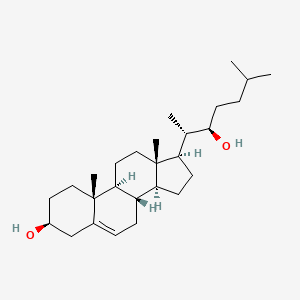| MeSH term | MeSH ID | Detail |
|---|---|---|
| Arteriosclerosis | D001161 | 86 associated lipids |
22(r)-hydroxycholesterol
22(r)-hydroxycholesterol is a lipid of Sterol Lipids (ST) class. 22(r)-hydroxycholesterol is associated with abnormalities such as Transient Ischemic Attack, Still, Neurodegenerative Disorders and Senile Plaques. The involved functions are known as Binding (Molecular Function), inhibitors, mRNA Expression, Gene Expression and Transcription, Genetic. 22(r)-hydroxycholesterol often locates in Blood, Protoplasm, Extracellular, Cytosol and Cytoplasm. The associated genes with 22(r)-hydroxycholesterol are CCL2 gene, IL8RB gene, CALCA gene and GRM5 gene. The related lipids are 22-hydroxycholesterol, Lipopolysaccharides, 15-deoxyprostaglandin J2 and 7-ketocholesterol.
Cross Reference
Introduction
To understand associated biological information of 22(r)-hydroxycholesterol, we collected biological information of abnormalities, associated pathways, cellular/molecular locations, biological functions, related genes/proteins, lipids and common seen animal/experimental models with organized paragraphs from literatures.
What diseases are associated with 22(r)-hydroxycholesterol?
22(r)-hydroxycholesterol is suspected in Neurodegenerative Disorders, Transient Ischemic Attack, Senile Plaques and other diseases in descending order of the highest number of associated sentences.
Related references are mostly published in these journals:
| Disease | Cross reference | Weighted score | Related literature |
|---|
Possible diseases from mapped MeSH terms on references
We collected disease MeSH terms mapped to the references associated with 22(r)-hydroxycholesterol
PubChem Associated disorders and diseases
What pathways are associated with 22(r)-hydroxycholesterol
There are no associated biomedical information in the current reference collection.
PubChem Biomolecular Interactions and Pathways
Link to PubChem Biomolecular Interactions and PathwaysWhat cellular locations are associated with 22(r)-hydroxycholesterol?
Visualization in cellular structure
Associated locations are in red color. Not associated locations are in black.
Related references are published most in these journals:
| Location | Cross reference | Weighted score | Related literatures |
|---|
What functions are associated with 22(r)-hydroxycholesterol?
Related references are published most in these journals:
| Function | Cross reference | Weighted score | Related literatures |
|---|
What lipids are associated with 22(r)-hydroxycholesterol?
Related references are published most in these journals:
| Lipid concept | Cross reference | Weighted score | Related literatures |
|---|
What genes are associated with 22(r)-hydroxycholesterol?
Related references are published most in these journals:
| Gene | Cross reference | Weighted score | Related literatures |
|---|
What common seen animal models are associated with 22(r)-hydroxycholesterol?
There are no associated biomedical information in the current reference collection.
NCBI Entrez Crosslinks
All references with 22(r)-hydroxycholesterol
Download all related citations| Authors | Title | Published | Journal | PubMed Link |
|---|---|---|---|---|
| Mauduit C et al. | Leukemia inhibitory factor antagonizes gonadotropin induced-testosterone synthesis in cultured porcine leydig cells: sites of action. | 2001 | Endocrinology | pmid:11356700 |
| Cymeryng CB et al. | Effects of L-arginine in rat adrenal cells: involvement of nitric oxide synthase. | 1999 | Endocrinology | pmid:10385387 |
| Lee JH et al. | Androgen deprivation by activating the liver X receptor. | 2008 | Endocrinology | pmid:18450964 |
| Huang MC and Miller WL | Creation and activity of COS-1 cells stably expressing the F2 fusion of the human cholesterol side-chain cleavage enzyme system. | 2001 | Endocrinology | pmid:11356706 |
| Nguyen DH and Taub DD | Membrane incorporation of 22-hydroxycholesterol inhibits chemokine receptor activity. | 2003 | Exp. Cell Res. | pmid:12706121 |
| Demerjian M et al. | Activators of PPARs and LXR decrease the adverse effects of exogenous glucocorticoids on the epidermis. | 2009 | Exp. Dermatol. | pmid:19236478 |
| Kumar R et al. | Altered levels of LXR-α: crucial implications in the pathogenesis of vitiligo. | 2012 | Exp. Dermatol. | pmid:23163651 |
| Chen W et al. | Testosterone synthesized in cultured human SZ95 sebocytes derives mainly from dehydroepiandrosterone. | 2010 | Exp. Dermatol. | pmid:20337700 |
| Hsu CC et al. | Regulatory mechanism of Cordyceps sinensis mycelium on mouse Leydig cell steroidogenesis. | 2003 | FEBS Lett. | pmid:12753921 |
| Marinero MJ et al. | Specific effect of arachidonic acid on 17beta-hydroxysteroid dehydrogenase in rat Leydig cells. | 1998 | FEBS Lett. | pmid:9475159 |
| Chiang JY et al. | Regulation of cholesterol 7alpha-hydroxylase gene (CYP7A1) transcription by the liver orphan receptor (LXRalpha). | 2001 | Gene | pmid:11179691 |
| Ceroi A et al. | The anti-inflammatory effects of platelet-derived microparticles in human plasmacytoid dendritic cells involve liver X receptor activation. | 2016 | Haematologica | pmid:26635040 |
| Yoon JH et al. | Oxysterols induce cyclooxygenase-2 expression in cholangiocytes: implications for biliary tract carcinogenesis. | 2004 | Hepatology | pmid:14999691 |
| Norata GD et al. | Liver X receptor and retinoic X receptor agonists modulate the expression of genes involved in lipid metabolism in human endothelial cells. | 2005 | Int. J. Mol. Med. | pmid:16142410 |
| Hedger MP and Eddy EM | Leydig cell cooperation in vitro: evidence for communication between adult rat Leydig cells. | 1990 Jan-Feb | J. Androl. | pmid:2155894 |
| Meikle AW et al. | Extracellular calcium and luteinizing hormone effects on 22-hydroxycholesterol used for testosterone production in mouse Leydig cells. | 1991 Mar-Apr | J. Androl. | pmid:2050582 |
| Wu CS et al. | Melatonin inhibits the expression of steroidogenic acute regulatory protein and steroidogenesis in MA-10 cells. | 2001 Mar-Apr | J. Androl. | pmid:11229798 |
| Sugano S et al. | Identification of intermediates in the conversion of cholesterol to pregnenolone with a reconstituted cytochrome p-450scc system: accumulation of the intermediate modulated by the adrenodoxin level. | 1996 | J. Biochem. | pmid:8947841 |
| Koldamova RP et al. | 22R-hydroxycholesterol and 9-cis-retinoic acid induce ATP-binding cassette transporter A1 expression and cholesterol efflux in brain cells and decrease amyloid beta secretion. | 2003 | J. Biol. Chem. | pmid:12547833 |
| Venugopal S et al. | Plasma Membrane Origin of the Steroidogenic Pool of Cholesterol Used in Hormone-induced Acute Steroid Formation in Leydig Cells. | 2016 | J. Biol. Chem. | pmid:27815506 |
